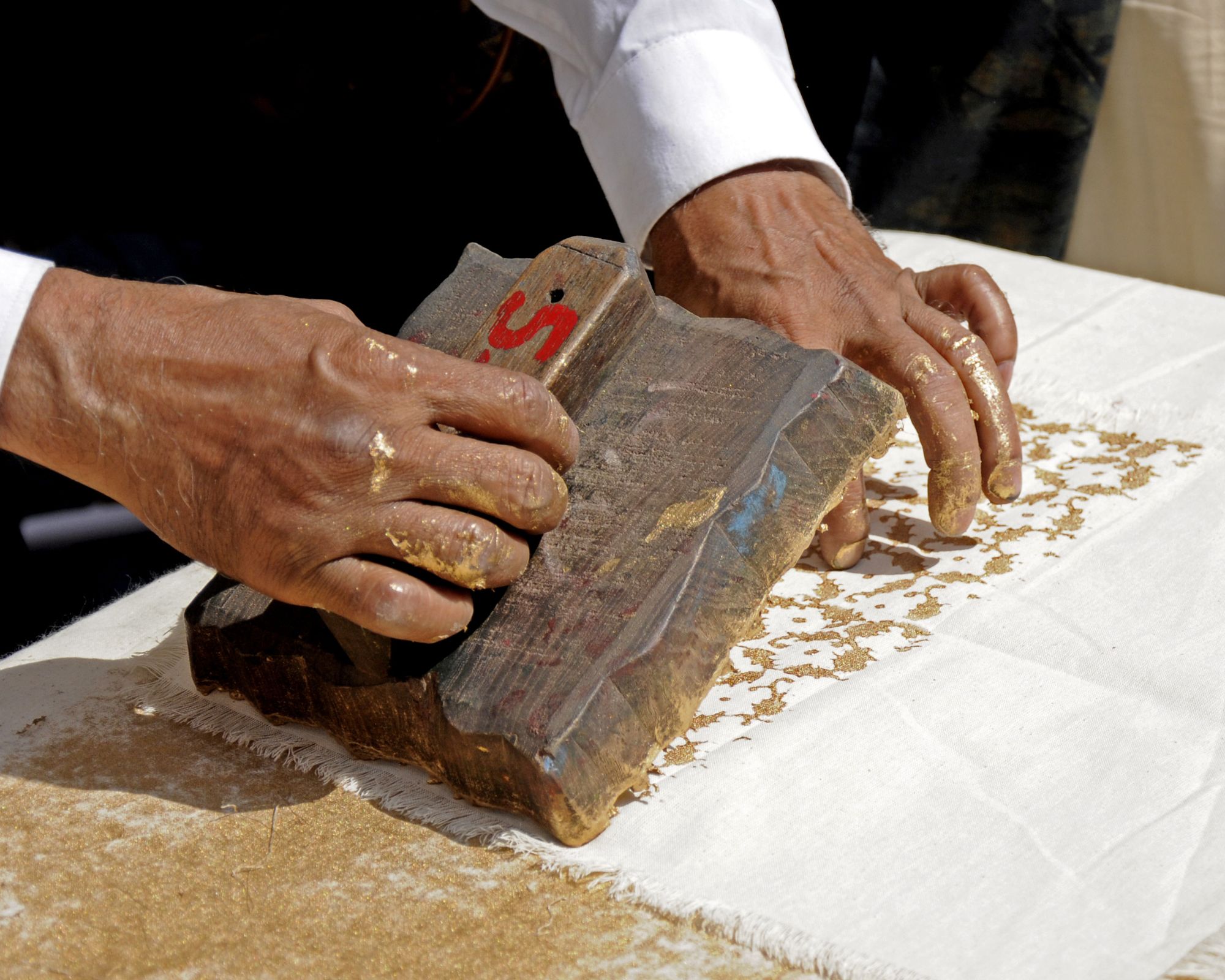What does cultural sustainability mean in fashion? Good On You’s rating analyst Jessica Ouano speaks with Indigenous artisans, brands, and cultural sustainability experts to help you understand one of the most important topics in fashion that’s too often left out of sustainability conversations. Plus, learn what brands can actually do about it.
Modern fashion’s ‘sacrifice zones’—a system rooted in racism
What constitutes “luxury”? Handcrafted garments from heritage labels in France or Italy are often the first examples that spring to mind. Meanwhile, luxurious handcrafted textiles and garments from the Global South are seen as less valuable, less fashionable, and less, well, white Eurocentric. There’s no way of getting around it: racism is built into the modern fashion industry at all levels, from luxury down to fast fashion’s cultural appropriation.
The fact that modern supply chains are built on the legacies of colonialism and systematic racism is itself not a new observation. In 2016’s Imperialism in the Twenty-First Century, for example, the author and researcher John Smith traced the typical supply chains of several iconic consumer goods—t-shirts, iPhones, coffee—to paint a grim picture of the current state of imperialism on a global scale. Diving deeper into the fashion context, Aja Barber’s groundbreaking 2021 book Consumed explores the connection between colonialism in fashion’s supply chains, overconsumption, and “the need for collective action”, as the subtitle reads.
Thanks to the ongoing work of labour leaders, unions, and human rights advocates, there’s growing global awareness of how fashion brands infamously exploit garment workers, the majority of whom are women of colour.
But far less discussed is modern fashion’s direct negative impacts on local and Indigenous cultures, which has its roots in the same destructive systems as labour exploitation.
Throughout history, the fashion industry has thrived by appropriating textiles, garment styles, and designs from other cultures to cater to western tastes, essentially built on colonial exploitation.
Niha Elety
The racist sin at the core of colonialism was not only exploitation, but a systematic aim to “civilise” colonised peoples whose cultures, histories, and creativity were deemed “less socially advanced”. This resulted in a forced and violently policed “westernising” of the way colonised communities presented themselves.
The outcome? The eradication of diverse, rich cultures and ways of dressing in favour of homogenous fashion, where all people across the world wear the same type of clothing regardless of their original culture. Anthropologist Sandra Niessen describes these as fashion’s “sacrifice zones”—natural and cultural systems considered expendable for the growth of the fashion industry in the Global North.
The fight against these powerful imperialist forces is often framed as “cultural sustainability.” That may sound like another buzzy phrase, but it’s far more urgent than that. Cultural sustainability must become central to fashion’s agenda in order to achieve labour and environmental justice for those negatively affected by the contemporary fashion system.
“Throughout history, the fashion industry has thrived by appropriating textiles, garment styles, and designs from other cultures to cater to western tastes, essentially built on colonial exploitation,” Niha Elety—a cultural sustainability advocate, influencer, and founder of the brand Tega Collective—tells me. “Today, many fashion brands continue to mass produce textiles and silhouettes associated with cultures to which they do not belong.”
Without a significant course correction, we simply keep repeating colonialism. And a slightly more environmentally friendly approach to colonialism is, obviously, still colonialism.
How imperialistic fashion harms local Indigenous culture
The mainstream global fashion system, whether it’s luxury or fast fashion, has many impacts on cultures across the world. In the Global South, it’s responsible for declining demand for locally made products that represent the culture of a specific place which ultimately results in the disappearance of valuable traditional craft skills.
This is how Eva Ilul, weaver and member of the Yakan Indigenous community in the Philippines, describes it to me: “My grandmother mentioned to me that we used locally available natural fibres like cotton and natural dyes from turmeric and gumamela flowers. However, this was not passed on to the next generation,” she recounts. “When foreigners came to the Philippines, polyester yarn started to become available and from then the tradition of using natural fibres and dyes disappeared.”
“My grandmother told me that 100% cotton yarn was widely available during her time but now it is so difficult to find. Not a single member of the community recalls how to do natural dyeing,” she explains. Ilul founded Tuwas Yakan weavers to help promote and sell handcrafted products made by her community.
Cultural appropriation’s very real consequences
Another undeniable factor is cultural appropriation, which further contributes to the loss and devaluing of cultural heritage and tradition. In numerous situations the crafts of Indigenous communities have been exploited by fashion brands without acknowledgement or economic benefit to the Indigenous artisan communities that the craft originated from.
While some of these cases lead to legal proceedings, there are few protections in place to safeguard Indigenous material culture, allowing fashion brands to freely use the cultural heritage of others as a source of inspiration despite public backlash.
The continued appropriation of patterns and embroidery from Indigenous communities makes headlines on a regular basis: Take Carolina Herrera’s resort 2020 collection—intended as a homage to Latin America, it featured patterns that prompted the Mexican government to accuse Herrera of plagiarising Indigenous communities. The development of legal protections for the country’s intangible cultural heritage has since been set in motion. In 2019, Max Mara faced accusations from the Laos-based Traditional Arts and Ethnology Centre that it had stolen embroidery and appliqué designs of the Oma people. And Isabel Marant’s spring/summer 2015 collection, which copied a traditional Mexican blouse from Oaxaca, resulted in a lawsuit in France.
While some of these cases lead to legal proceedings, there are, unfortunately, few protections in place to safeguard Indigenous material culture, allowing fashion brands to freely use the cultural heritage of others as a source of inspiration despite public backlash.
Certainly, in some cases, fashion brands and designers may unintentionally contribute to the problem, but that makes the consequences no less real. Fashion schools can help by more forcefully teaching their students to value and respect cultures beyond their own.
In cases where seemingly well-meaning brands carry out social impact projects, we still too often see it in the spirit of eugenics. As noted in Francesco Mazzarella and Migle Radziunaite’s 2023 report, Reality, Reciprocity, Resilience: Scoping a Decolonised Process of Designing for Cultural Sustainability with Refugee Communities, “designers are sometimes ‘parachuted’ into marginalised communities with the assumption that they can bring their knowledge and expertise to solve [the communities’] problems.” This has often resulted in top-down solutions that do not effectively address the specific needs and aspirations of diverse local communities, nor honour the cultures from which they originate. Ultimately, it demonstrates the urgency for culture to be considered a key pillar in fashion sustainability in order to decolonise the industry
“Brands can continue to support us by using our textiles in their work,” Ilul says. “If we don’t have buyers then we might not continue weaving and that would mean we can longer pass on our weaving traditions to the next generation.”

What do we mean when we say cultural sustainability?
In the context of fashion, cultural sustainability is a growing movement seeking to rectify the biases of the past and reform the current system to one that recognises and cultivates diversity in fashion and the wider sustainability discourse. The Cultural Intellectual Property Rights Initiative® stands out as a key organisation leading this work, and in the process of my own research into the subject, I attended Cultural IP Month – Cultural IP Rights are Human Rights programming, an accessible entry point for anyone looking to dive deeper into the topic.
But what do we mean when we say cultural sustainability? Building on definitions from CIPRI and the wider range of experts I spoke with for this piece, it’s about the access, use, and adaptation of cultural heritage while ensuring the communities that are custodians of this heritage and future generations are not harmed in the process. That also requires us to shift the narrative to focus on the skill and labour behind it all—recognising the value of craftsmanship and continued craft innovation, shifting to a paradigm where we see Cultural IP Rights as Human Rights, as conceptualised by Monica Boța Moisin, founder of CIPRI.
“Cultural sustainability helps to amplify and pass cultural knowledge and practices to future generations by honouring the people and work before us,” says Elety. “Textile craftsmanship plays a vital role in preserving cultural legacies and shaping distinct cultural identities through the traditional attire of various global communities and Indigenous groups. These textiles go beyond design, symbolism and storytelling, their actual creation is sustainable in itself.”
Indeed, cultural sustainability initiatives have been recognised as an important lever of sustainable development that have potential community-wide social, economic, and environmental impacts.
“Many of our ancestral practices—such as regenerative agriculture, natural dyeing, block printing, hand-loom weaving, growing native bio-regional fibres, and stewardship by Indigenous communities—are used when creating clothing,” Elety says. “Communities have reciprocal relationships with the environment and labour. These practices offer promising solutions to our climate crisis by Indigenising fashion supply chains to create a thriving ecosystem.”
How can fashion brands approach cultural sustainability?
Why, then, isn’t cultural sustainability widely discussed in the fashion industry?
The cynical answer is uncomfortable but familiar: in our globalised, capitalist world, fashion brands are for-profit companies that would rather focus on sustainability projects that can quickly deliver the greenwashing spin, says Elety.
“Given their large-scale operations, [the most profitable] brands tend to gravitate toward ‘one-size-fits-all’ solutions,” she explains—whether that’s carbon offsets to back up a net-zero claim or pivoting to recycled polyester as a “conscious” choice, as goes the story with many fast fashion brands.
The more nuanced answer is that cultural sustainability is hard but necessary work. “To tackle the multifaceted challenges, we must integrate various approaches to address location-specific needs, uphold human rights, and provide reparations to communities and countries affected,” Elety says.
Determining best practices in this context can be difficult, because every community is different. For example, the goal of preserving and celebrating Indigenous cultures may not always be applicable depending on an individual’s experience of their own culture, particularly if it involves trauma. Plus, research on cultural sustainability in fashion is currently in its infancy. To this end, in my role as ratings analyst at Good On You, I’m currently collaborating with the ratings team on approaches to better integrate cultural sustainability into Good On You’s methodology, which is constantly reviewed and updated to comprehensively address the ethical and sustainability issues in fashion supply chains. Elements of current best practices are already factored into how we rate brands on some issues, and we also recognise how frameworks are evolving.
There is a tension between the ambition to sustain cultural heritage and the responsibility to let people embrace other cultures as a vehicle for social integration.
Francesco Mazzarella – senior lecturer, London College of Fashion
Despite the nuanced landscape, there are clear ways forward for brands that want to do better and consumers who want to support them, thanks to the work of academics, designers, entrepreneurs and activists.
Francesco Mazzarella, senior lecturer in fashion and design for social change at the London College of Fashion, is the principal investigator on the project Decolonising Fashion and Textiles: Design for Cultural Sustainability with Refugee Communities.
“In my project, there is an ambition to sustain cultures and foster a sense of belonging through fashion and textiles,” Mazzarella says “But we also need to be mindful of not being tokenistic. Some refugees have very traumatic memories of their home countries, and they want to erase their own culture, and try to integrate in the new place of resettlement, also through the clothes they wear… There is a tension between the ambition to sustain cultural heritage and the responsibility to let people embrace other cultures as a vehicle for social integration. It is very tricky”.
‘Collaborate with Indigenous craft communities as partners instead of stealing their work’
In approaching cultural sustainability, Mazzarella recommends first considering what is needed on a local level in order to adapt the best practices.
It’s similar to what’s recommended by CIPRI’s 3Cs’ Rule: Consent. Credit. Compensation©, which aims to address issues of cultural appropriation and power imbalances within the fashion industry, promoting respect, collaboration, and equitable partnerships with Indigenous communities. Fashion brands are encouraged to adopt this in their engagement with Indigenous artisan communities. The 3Cs stand for, as defined on CIPRI’s website:
- Consent (“Free, Prior and Informed Consent of the craftsperson, indigenous or local community”);
- Credit (“acknowledgement of the source community and inspiration”);
- Compensation (“monetary, non-monetary or a combination of the two”).
Ultimately, conversations about cultural sustainability—and related instances of cultural appropriation—should lead back to the power that brands have to forge a different and better path than the colonial, racist dynamic that has become the status quo. Consumers, too, can choose to support the brands that take cultural sustainability seriously.
“Fashion brands can collaborate with Indigenous craft communities as partners instead of stealing their work,” Elety concludes. “It means partnering with communities that are already trying to make profits from their craft, moving towards localised systems, restoring native-fibre farming practices and use of garments, expanding the aesthetics we idolise, and reckoning with the way we value clothing.”



















